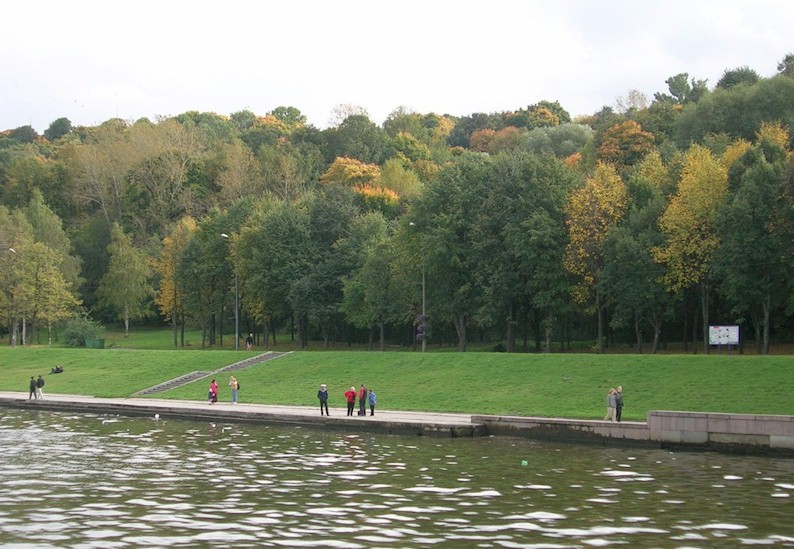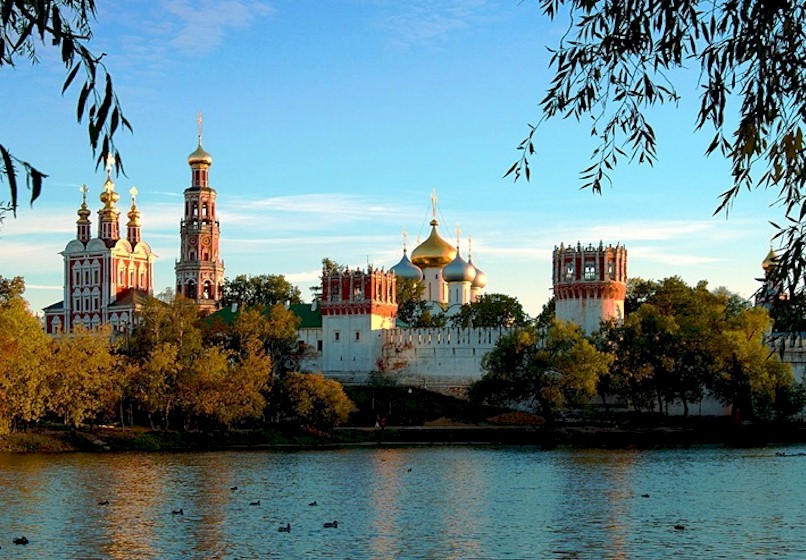31. On Sparrow Hills
English > The novel > Annotations per chapter > Chapter 31
Sparrow Hills
From this spot, called Воробьёвы горы [Vorobyovy gory]) in Russian, Woland, Koroviev, Azazello and Behemoth said goodbye to Moscow, sitting on black horses. Together with the master and Margarita they rose into the air and galloped.
The Sparrow Hills - in reality it is only one long hill - are situated on the right bank of the Moskow River and reach a height of 220 meters above the sea level, and between 65 and 85 meters above the river level.
Once, the Moscow Council for the Renovation of the City had decided to install the sculpture group which was by made the sculptor Aleksandr Yulianovich Rukavishnikov (°1950) to honour Bulgakov on Sparrow Hills, in a little park on the Moscow river, between Andreevskaya Naberezhnaya and Kosygina ulitsa. At first his monument should have been placed in the park of the Patriarch's Ponds. But the saga of those sculptures takes so long that we hardly dare to refer to them anymore.
In 1953, the Moscow State University - one of Joseph Stalin's so-called Seven Sisters - was built on the hills. These sisters are seven rather bombastic skyscrapers in Moscow, sometimes also called the wedding cakes because of their typical shape. The university campus is situated 220 meter above sea level and 85 meter above the river banks. The observatory with view on Moscow can be reached with a funicular.
Not far from the observatory is the well known Metromost, a metro station on a bridge over the river. This bridge, connecting Komsomolsky Prospekt to Vernadsky Prospekt, has two levels: one for car traffic, and one for the metro. The metro station Vorobyovye Gory with his wall of glass is situated at the lower level.
In 1935, the Sparrow Hills were renamed into Ленинские горы [Leninskye gory] or Lenin Hills. This name was kept until 1999.
Click here to read more about Sparrow Hills and environment
The Devichy Convent
Close to the Sparrow Hills is the Новодевичье кладбище [Novodevitche kladbyshche] or Novodevichy convent. The convent was founded in 1524 by великий князь [veliki knyaz] or Grand Prince of Moscow Vasily III (1479-1533) to commemorate the reconquest of Smolensk on the Lithuanians. But most of the currently existing buildings are from the 17th century. It was here that Boris Fyodorovich Godunov (1551-1605) was elected czar andSofia Alexeevna (1657-1704), the imperious sister of czar Peter the Great (1672-1725), was imprisoned.
The Novodevichy convent has one of the most famous graveyards of Russia. party leader Nikita Sergeevich Khrushchov (1894-1971), film director Sergey Mikhailovich Eisenstein (1894-1971), former minister Vyatsheslav Mikhailovich Molotov (1890-1986), writer Anton Pavlovich Chekhov (1860-1904), aviation pioneer Andrey Nikolaevich Tupolev (1888-1972), composer Sergey Sergeevich Prokofyev (1891-1953)... and Mikhail Anasafievich Bulgakov (1891-1940) are buried here.
Bulgakov lies here with his third wife Elena Sergeevna Nyurenberg (1893-1970). When Elena Sergeevna was searching for a nice stone for the grave of Bulgakov, she found a block of granite coming from the Crimea. Later it appeared to be the tombstone of the original grave of Nikolay Vasilyevich Gogol (1809-1852).
Fingers in his mouth and whistle
This strong kind of whistle is rather common in Russian folklore. Соловей-Разбойник [Solovey-Razboynik], for example, was a lengendary robber who could kill his enemies with his whistle. He lived in the woods in the neighbourhood of Bryansk. He used to hide himself in the trees on the way to Kyiv and to overwhelm foreigners by his whistle.
A huge slab of the bank sagged into the river
This sentence refers to what happened in the 19th century with the well-known Moscow cathedral of Christ the Saviour. Originally, the then tsar Alexander I (1777-1825) had promised to build it on the spot where the wooden Vorobyoy palace was destroyed in 1812 after the great fire that forced Napoleon Bonaparte (1769-1821) to withdraw from Moscow.
The plans for a neoclassical design with a lot of Masonic symbols were made by architect Aleksander Lavrentevich Witberg (1787-1855) or Carl Magnus Witberg - he was of Swedish descent - but it turned out to be impossible to build the cathedral on the planned spot.
In 1817, the first stone for the Cathedral of Christ the Saviour was laid on Sparrow Hills. The Cathedral was planned to be built on the top, and to descend to the Moskow River via three terraces. But during the ground works it appeared that the mountain began to crumble and slide down, and in 1827 the construction was stopped. Twelve years later, in 1839, the construction of the Cathedral was resumed on a spot closer to the Kremlin, and to a design by architect Konstantin Andreevich Thon (1794-1881).
Share this page |
Chapters
- Introduction
- 1 Never Talk with Strangers
- 2 Pontius Pilate
- 3 The Seventh Proof
- 4 The Chase
- 5 There were Doings at Griboedov's
- 6 Schizophrenia, as was Said
- 7 A Naughty Apartment
- 8 The Combat between the Professor...
- 9 Koroviev's Stunts
- 10 News From Yalta
- 11 Ivan Splits in Two
- 12 Black Magic and Its Exposure
- 13 The Hero Enters
- 14 Glory to the Cock!
- 15 Nikanor Ivanovich's Dream
- 16 The Execution
- 17 An Unquiet Day
- 18 Hapless Visitors
- 19 Margarita
- 20 Azazello's Cream
- 21 Flight
- 22 By Candlelight
- 23 The Great Ball at Satan's
- 24 The Extraction of the Master
- 25 How the Procurator Tried...
- 26 The Burial
- 27 The End of Apartment No. 50
- 28 The Last Adventures of Koroviev...
- 29 The Fate of the Master and...
- 30 It's Time! It's Time!
- 31 On Sparrow Hills
- 32 Forgiveness and Eternal Refuge
- Epilogue
English subtitles

All films based on The Master and Margarita are subtitled in English, French, German, Dutch, Spanish and Italian.

